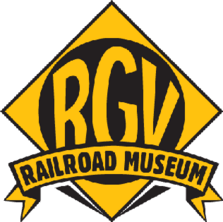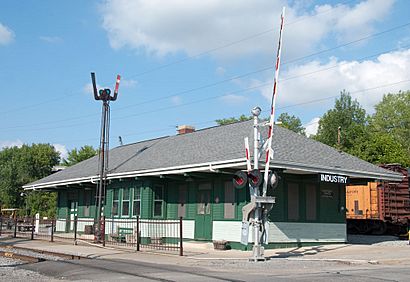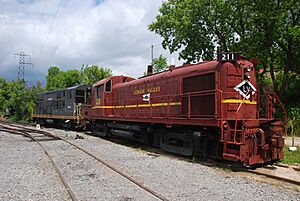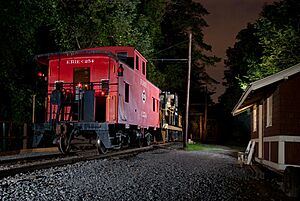- This page was last modified on 17 October 2025, at 10:18. Suggest an edit.
Rochester & Genesee Valley Railroad Museum facts for kids
 |
|
| Established | 1971 |
|---|---|
| Location | Industry, New York |
| Type | Railroad museum |
The Rochester and Genesee Valley Railroad Museum (RGVRRM) is a fun place to visit in Industry, New York. It's a special museum where you can see and even ride historic trains! The museum began in 1971 when it bought an old train station.
Since then, it has grown a lot. It now has a one-mile demonstration railroad. This track connects the museum to the New York Museum of Transportation. This makes it one of the few railroad museums in New York State where trains actually run.
The museum has over 40 pieces of old railroad equipment. This includes diesel and steam locomotives, electric trolley cars, freight cars, and passenger cars. You can also see old train buildings. These include the 1909 Industry Depot and a crossing watchman's shanty. The museum offers train rides and is open on certain weekends from June to October. It is run entirely by volunteers who love trains!
Contents
A Look Back at the Museum's Home
The Railroad's History in Industry
The area where the RGVRRM is located has been important for railroads since 1851. That's when the first railroad, the Rochester and Genesee Valley Railroad, was created. An early train station here served the nearby village of Scottsville from 1853 to 1874. It helped bring mail, packages, and people to the village every day.
Later, in the early 1900s, the Erie Railroad added electric trains to this line. This was the only part of the Erie Railroad that used electricity. Electric service started on June 18, 1907. Trains ran every hour from Rochester to Mount Morris. However, this electric service stopped in 1934 because it was too expensive.
Passenger train service ended in September 1941. But freight trains still used the line for many years. The Industry train station was used for freight until the mid-1950s. After that, it was used for storage. Today, a company called the Livonia, Avon and Lakeville Railroad still uses part of this old route.
The train station has had a few different names over the years. First, it was called Scottsville. Then, it was named Oatka, after a nearby creek. In 1902, a school for boys moved to the area. So, when the current station was built around 1909, its name was changed to Industry. This name reflected the small community that grew around the school.
How the Museum Started
|
Industry
|
|||||||||||
|---|---|---|---|---|---|---|---|---|---|---|---|

The former Erie Railroad depot in 2010. The semaphore train order signal and milepost denoting the length to Jersey City, New Jersey are visible.
|
|||||||||||
| Location | 282 Rush Scottsville Road (NY 251), Rush, New York 14543 | ||||||||||
| Coordinates | 43°00′13″N 77°43′16″W / 43.0035°N 77.721°W | ||||||||||
| Owned by | Erie Railroad | ||||||||||
| Line(s) | Rochester Branch | ||||||||||
| Platforms | 1 side platform | ||||||||||
| Tracks | 1 | ||||||||||
| Other information | |||||||||||
| Station code | 3975 (Erie Railroad) | ||||||||||
| History | |||||||||||
| Opened | 1853 | ||||||||||
| Closed | September 30, 1941 (passenger service)
November 20, 1950 (agency) |
||||||||||
| Rebuilt | 1909 | ||||||||||
| Previous names | Scottsville (1853–1903)
Pixley (1903–1906) Oatka (1906–1909) |
||||||||||
| Former services | |||||||||||
|
|||||||||||
The Rochester Chapter of the National Railway Historical Society started in 1937. By the late 1960s, they had collected many old train items. They were ready to open a museum. After looking at several places, they chose the old Erie Depot in Industry.
This depot was built in 1909. It had two waiting rooms, separated by the agent's office. Back then, it was common to have separate waiting areas for men and women. Later, one waiting room was used to keep students from the state school separate from the public.
The last passenger train stopped at Industry on September 30, 1941. The depot closed in 1950. The Rochester Chapter found out the depot was available. It had been empty since 1957. By December 1969, they decided it would be their new home. They bought the depot in 1971 for just $1.00! Volunteers worked for years to restore the depot. It now looks like it did in the 1930s.
Since getting the depot, the museum has grown a lot. Volunteers built new tracks. In 1979, the first piece of equipment, a caboose, arrived. In 1981, the museum got its first locomotive, EK 6, from Eastman Kodak. Volunteers kept adding more trains and equipment. This led to the completion of a one-mile demonstration railroad in 1993.
At first, visitors rode on small track cars. Now, diesel-powered trains give rides for special events. The museum started its popular "Diesel Days" weekend in 1998. This event shows off their collection of working diesel trains. Since 2010, all rides are given by diesel trains pulling restored cabooses. The museum keeps growing and plans to add more storage for its unique collection. It's special because most of its trains are kept in working condition. This makes visiting even more exciting!
Amazing Train Collection
The Rochester & Genesee Valley Railroad Museum has a very large collection of trains. It includes 10 locomotives, 13 freight cars, 15 passenger cars, and other railroad equipment.
One special train is the "Hammerhead" Lehigh Valley Railroad RS3m 211. It's part of the trains that can still run. The museum also has the only remaining trolley car (Car # 60) from the old Rochester Subway. This car returned to the museum in 1998. In 1998, a steel building was built to help keep the trains safe and restore them. In 2007, seven old passenger coaches from the 1941 Empire State Express arrived. These are used for special Fall Foliage trips.
Rochester is known as the "World's Image Center" because of photography and Eastman Kodak. So, the museum has many old photos. A special collection includes steam-era pictures from Robert Carper. Many photos from his book are now on display at the museum.
The museum also has a large collection of signaling equipment. Rochester was home to General Railway Signal, a company that made train signals. The museum hopes to set up and operate signals on its railroad in the future. They have a working semaphore signal, searchlights, and other old signal machines.
Locomotives: The Power of the Rails
| Locomotive | Type | Source | Year Acquired |
|---|---|---|---|
| EK 6 | GE 80-ton switcher | Eastman Kodak | 1981 |
| LV 211 | ALCO RS-3m | Conrail via Genesee Valley Transportation Company | 1986 |
| RG&E 1941 | GE 45-ton switcher | Rochester Gas and Electric | 1991 |
| USA 1843 | FM H-12-44 | Seneca Army Depot | 1993 |
| EK 9 | Alco RS-1 | Eastman Kodak | 1997 |
| CL&P 2 | Hiesler Fireless 0-4-0 | Connecticut Light & Power | 1997 |
| R&GV 54 | GE 80-ton switcher | US Army/DLA | 2001 |
| RG&E 8 | GE 110-ton switcher | Rochester Gas and Electric | 2008 |
| RG&E 1950 | GE 45-ton switcher | Rochester Gas and Electric | 2008 |
| LA&L 20 | Alco RS-1 | Livonia, Avon and Lakeville Railroad | 2016 |
| NKP 79 | Alco S-4 | Nickel Plate Road | 2016 |
| DS #5 | Vulcan 0-4-0T | Mortimer & Red Creek Railroad Museum | 2023 |
| LA&L 72 | Alco S-4 | Livonia, Avon and Lakeville Railroad | 2023 |
| B&H 5 | ALCo S-1 | New York Central Railroad | 2025 |
Passenger Cars: Riding in Style
The museum has many different types of passenger cars. In 1988, the museum and some members bought five old stainless steel coaches from Metro-North Railroad. These cars were built in 1941. More coaches and a baggage car were added later. These cars have been used for fun train trips. They are being fixed up with new windows and better heating systems.
Another interesting car is the "Pine Falls." This was a sleeper-lounge car built in 1939 for the Pennsylvania Railroad. The museum also has the very last car from the last electric train that left Hoboken Terminal in 1984.
Two baggage cars are also part of the collection. One old Baltimore & Ohio baggage car is used as a tool car and workshop. Another old Lackawanna baggage car has been fixed up to hold displays. An old Pennsylvania Railroad mail car is also being restored to hold more displays.
Freight Cars: Carrying Goods by Rail
The museum has 13 pieces of freight equipment. Two cabooses are used most often. Erie C254 was restored in the mid-1990s and is used regularly. It was built in 1946. Penn Central 18562 was built in 1969. It was given to the museum in 1996 and restored to its original look.
MDT 14053 is a refrigerated boxcar that used ice to keep things cold. It was built by Pacific Car and Foundry. This car now holds displays about the Despatch Shops, where thousands of similar cars were built. An old Lehigh Valley Railroad caboose, 95100, was bought in 2011 to be restored. In 2014, a flatcar from the U.S. Army was acquired. It was turned into an open-air car for riders and started service in August 2017.


